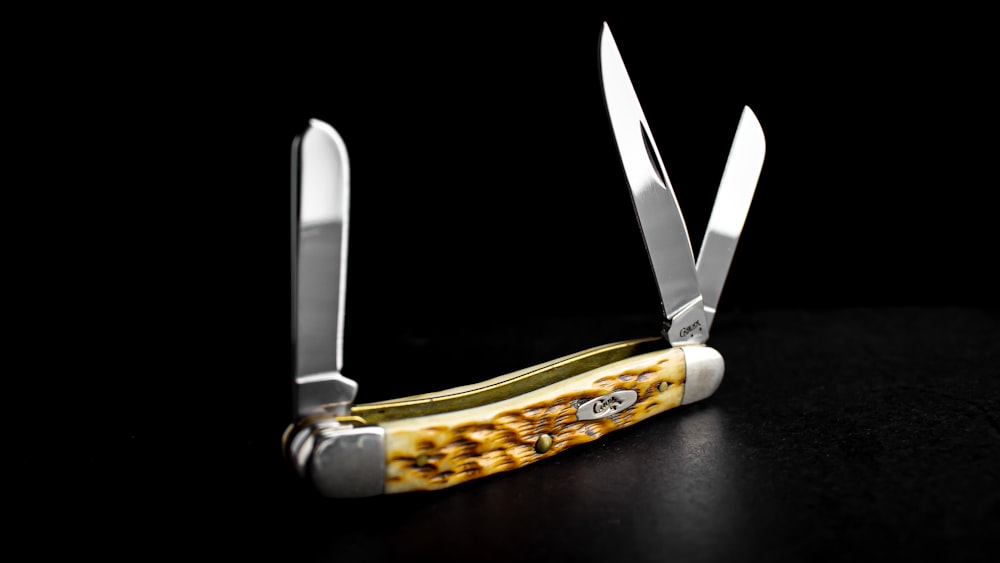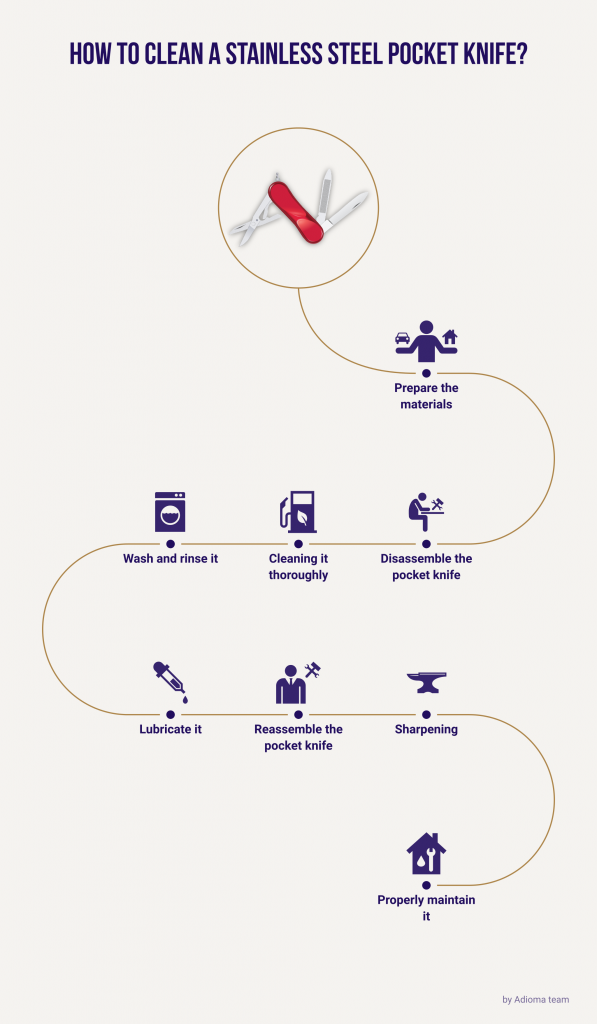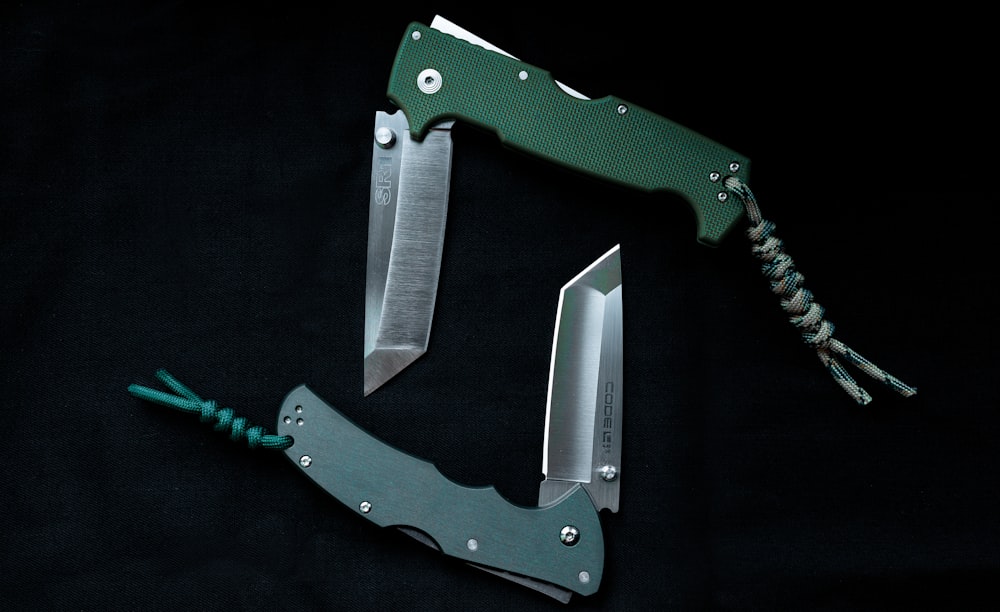Pocket knives are a convenient and versatile tool to have around. Pocket knives may last like cast iron pans or quality leather shoes. Your stainless steel pocket knife can provide you with many years of reliable service with proper care and cleaning. If you don’t take care of a blade for a long time, it could get rusty and break when you need it the most.
This article will give you complete coverage on how to clean a stainless steel pocket knife.
Why Does A Stainless Steel Pocket Knife Need Cleaning?

Like any other piece of equipment, a pocket knife needs to be appropriately cleaned and maintained to work at its best. If you don’t clean it regularly, dirt and debris can build up on the blade and handle, leading to corrosion, rusting, and other damage.
You should check your pocket knife right away. Open the blades and look inside. Is it dirty? What about the pivot point? Is it accumulating dirt? Do the blade and other metal parts show signs of rust? Is it easy to open and close, or do you have to push on it?
If so, giving it a good cleaning is essential. Even the best stainless steel pocket knife soon won’t be useful if you don’t.
How to Clean A Stainless Steel Pocket Knife?

📌Materials needed
Of course, it’s essential to know what you’ll need before doing any task. Here’s a list of items you’ll need to clean your stainless steel pocket knife:
- Bucket or container: We need to use a large basin or bucket to submerge the knife.
- Stiff brush like an old toothbrush: A stiff brush is necessary to clean off the knife’s dirt build-up.
- Q-tips and toothpicks: These small items help get into tight spaces and clean the pivot point.
- Soft cloths or paper towels: We’ll need these to dry the knife when we’re finished.
- Lubricant like mineral oil, gun, or sewing machine oil: Not all knives require oiling, but if your knife does, use a light lubricant. Too much oil can attract dust and dirt.
- Mild dish soap: A small amount of dish soap is all we need to help cut through any build-up on the knife.
- Warm water: Enough to submerge the knife and help with cleaning.
- Sharpening stone and honing rod: If your knife is dull, you can use a honing rod and sharpening stone to bring the blade back to its original sharpness.

📌Disassemble the pocket knife
Most knives nowadays have Torx bit hardware, even pocket knives. If you don’t have the correct Torx driver bit, you can use a quarter as a substitute.
If your knife doesn’t have Torx bit hardware, you will have to use a screwdriver to take it apart. You should be careful when you remove the screws. Take a moment to put them back in order as you go. They look the same, but screws can have minimal differences in bit size, thread size, or length, which can cause significant problems when you try to put them back together.
You should never try to push screws. If it doesn’t turn, stop! Do not move it! A lot of knives come with Loctite, which is red. It helps keep the screws in place. Ensure you get your heat gun out of the garage or look for your partner’s hairdryer in the closet. In no time, you’ll be able to get your knife apart with a bit of heat.
If you didn’t read the previous instructions and stripped the screws on your knife, don’t worry about it. You can still use your knife. Most manufacturers will send you new hardware for free or for a small fee. If something bad happens, you can always get your calipers out and order some new ones from the internet.
📌Cleaning it thoroughly
Getting sand, grime, and other dust out of this moving part is the most important reason to clean it. Such foreign objects make it hard for the joints to move smoothly. As long as the pocket lint isn’t too big, you can usually get it out with a toothpick or other probe.
If you have grit and sand, you may consider washing it with warm, soapy water and an old toothbrush to clean your knife. It would be best to brush down the blade and handle scales if you decide to do this. Often, this is all it takes to get your handle scales back to their original shine. Clean the insides with mild dish soap and water. Don’t forget to make sure you wash it well.
As an alternative, you can clean the point of your pocket knife without taking it apart or getting it wet. This method is also good if it’s dirty so much that you have to use more pressure to turn the blade. Simply use a q-tip and some lubricant on the pivot point.
If you have an old and rusty stainless steel pocket knife, you can use a vinegar bath to clean it. Soak the knife in white vinegar overnight. It will help loosen up the rust and make it easy to scrub off. Finishing with a baking soda paste will help give the knife a shine and protect it from further corrosion.
📌Wash and rinse it
Most of the time, it’s not a good idea to let your pocket knife get wet for a long time. For hard-to-clean mud and dirt, mild dish soap and water may be the only thing that can save your pocket knife’s original shine.
You may want to deeply clean your knife, but you don’t want to scrub it so hard that you lose its shine. Remember that the best way to clean your stainless steel pocket knife with soapy water is with a soft toothbrush and the soft side.
You can use mild dish soap and warm water to clean the knife. Submerging the handle in water is safe for most materials, except wood and a few other materials that are very sensitive to water. A little bit of soap is all you need to clean the whole knife.
Make sure you pay attention to the locking mechanism inside the handle and around the blade’s pivot when cleaning it. You can use a Q-tip to get inside your handle. The handle’s opening is small, so if the Q-tip is too big, press the tip with a heavy tool or hammer to help it fit through the hole.
When you wash your knife, the suds may not show the sharp part of the blade. If you need to, put some tape around the edge of your knife to keep it from cutting you, especially when you wash it with slippery soap.

📌Lubricate it
As soon as your pocket knife is dry, apply a thin layer of oil to the blade and any parts that move. Never put oil on the handle because it can stick to it and make it slippery. You can choose from a wide range of lubricants, but most are made from petroleum. You can also use lubricants typically used on door hinges, sewing machines, firearms, and other moving parts, like those in a car. You can also use food-safe oil like vegetable or mineral oil.
Remember that you don’t want to overdo it with the oil. It’s better to use less than you think you’ll need. If you oil it too much, it may be challenging and time-consuming to get rid of, so be careful. However, if you apply a small amount, you can add more. Wet lubricants only need a few drops at the most.
When you oil the knife’s part, the pivot is one thing to pay attention to. Put a small amount of lubricant on the blade, then open and close it a few times to get the blade moving inside. You can grab a toothpick and apply the oil.
📌Reassemble the pocket knife
You can put it back together after you’ve cleaned, dried, and lubricated your knife. There are times when things aren’t so easy. Some knife models can be hard to put back together again if you don’t know how to do it. So if you’re not sure, it’s always a good idea to take it to a professional or watch a video on how to do it before you try.
Many instructional videos on the internet show you how to reassemble your knife. If it doesn’t seem like it goes back together easily, you’re doing something wrong. Make sure your blade stays in the same place when you put screws into holes by putting a dot of blue Loctite on it. It will help keep the screws in place so your knife stays together. Make small changes to the tightness of your blade pivot.
Try closing and opening your blade several times. If it still doesn’t seem to be opening and closing easily, loosen the screws a little bit. You may need to make some small adjustments to the tightness of your blade pivot screws.
Sharpening Your Stainless Steel Pocket Knife

A dull knife is more dangerous than a sharp one because you have to use more force to get the job done. With a sharp knife, you can make precise cuts with little effort. There are many ways to sharpen your stainless steel pocket knife. The most common method is to use a sharpening stone or honing rod.
💥Sharpening stone
Choose the type of sharpening stone you want to use. There are three types: whetstones, diamond stones, and ceramic stones.
- Whetstones: Whetstones come in two types: oil stones and water stones. Most prefer oilstones because they’re stickier and don’t wear out as quickly. Water stones need to be wet while you’re using them.
- Diamond stones: Diamond stones are the most expensive, but they’re also durable. People buy diamond stones in various sizes, from hard to fine to extra-fine.
- Ceramic stones: Ceramic stones are the softest and least expensive of the three types. They wear out quickly, though, so they’re not as popular as the other two types.
💥Find the right angle.
Find out the angle of the blade’s bevel. When sharpening a blade, the two most important things are to know what angle to sharpen the blade at and to keep that angle as steady as possible during the sharpening process.
The blade must be honed at a certain angle if you use it to sharpen the knife. Also called the rough grind angle, this is where you start to cut the wood. If you want to carry a small knife, most have a beveled edge from 25 to 30 degrees.
💥Start sharpening
After finding the angle, you need to start sharpening the blade. It is the process of taking off metal to create a sharp edge. To do this, hold your knife against the sharpening stone at the same angle you found earlier. Push the knife down and away from you with moderate pressure as you drag it across the sharpening stone.
Do this for the entire blade length, going back and forth. You’ll need to do this a few times to get a good edge on your knife. Once you’ve done that, you can start polishing the blade using a finer sharpening stone. If your knife has a serrated edge, you’ll need to use a different technique.
💥Honing rod
Another way to sharpen your knife is to use a honing rod. It is a long, metal bar with a V-shaped notch in the middle. The honing rod is used to realign the blade’s edge.
Place the honing rod on a flat surface and put your knife blade in the V-shaped notch. Rub the blade up and down the honing rod as you move it down the entire length of the blade. Do this a few times to get a good edge on your knife.
Pocket Knife Maintenance and Proper Care

Stainless steel pocket knives are a popular choice because they’re durable and easy to clean. However, they require some basic maintenance to keep them in good condition.
Here are a few tips on cleaning and caring for your stainless steel pocket knife.
🔪Keep it clean and always dry.
The best way to keep your pocket knife clean and in good condition is to dry it. Wipe down the blade and handle after each use with a dry cloth. Storing a dirty knife in your pocket or purse can lead to rust and other damage.
Alternatively, while you chop various items, have a wet and a dry towel beside you. Instead of washing with water, wipe the knife tip with a moist cloth and then a dry towel. Storing a rusted knife is a recipe for disaster.
🔪Avoid storing it in the sheath.
The sheath is a great way to protect the blade when you’re not using it, but it’s not a good place to store the knife. The sheath can trap moisture and humidity, which can cause rust and other damage to the blade. Instead, store the knife in a dry place when you’re not using it.
🔪Clean them as soon as they show indications of rust.
If your knife starts to rust, you need to clean it as soon as possible. Rust can quickly damage the blade and make it difficult to sharpen. If your pocket knife starts to show any signs of rust, clean it immediately. Use a mild abrasive such as steel wool or scouring pads to remove the rust, and then polish the blade with a fine-grit sandpaper. Be sure to dry the blade completely before storing it.
🔪Always lubricate it.
Pocket knives feature joints that need to be lubricated to keep them moving freely. Use a light oil, such as 3-in-1 oil or WD-40, to lubricate the joints every few months. It will keep the knife functioning properly and help prevent corrosion.
Frequently Asked Questions
Q: Does mineral oil good for lubricating stainless steel pocket knives?
A: Mineral oil is good for lubricating stainless steel pocket knives. It’s a light oil that won’t damage the blade, and it’s easy to apply. Just a few drops will do the trick.
Q: Are pocket knives dishwashers safe?
A: Most pocket knives are not dishwasher safe. The detergents and heat can damage the blade and affect how it functions. It’s best to clean your pocket knife by hand, using a mild abrasive and lubricating oil.
Q: Can I use alcohol to clean my pocket knife?
A: It’s not recommended to use alcohol to clean your pocket knife. Alcohol can damage the blade and affect its performance. It’s best to use mild soap and warm water to clean your stainless steel knife.
Q: How often should I oil my pocket knife?
A: You should oil your pocket knife every few months or as needed. If the knife feels stiff or difficult to open and close, it’s time for a little oil. Just a few drops will do the trick.
Q: What can I do if my pocket knife blade is chipped?
A: If you have a chipped pocket knife blade, you may be able to repair it yourself. Use fine-grit sandpaper to smooth out the chip, and then polish the blade with a cloth. Be sure to dry the blade completely before using it. If the chip is too large, you may need to take the knife to a professional for repair.
Final Thoughts
Pocket knives are a convenient and useful tool, but they require some basic maintenance to stay in good condition. Maintaining a good functioning quality for your cutting tool helps guarantee that it does not struggle or fail in important instances. After using it, clean it with a dry cloth and store it in a safe place. If the pocket knife gets rusty, oil it and try to clean off the rust before it becomes too severe.
Cleaning it is also an excellent approach to look for additional problems, such as loose screws or rust on the internal components and blade. If any of these are detected, it is time to take the knife to a professional for repair. To keep your stainless steel pocket knife working smoothly for a long time, follow these tips, and you will be on your way!
